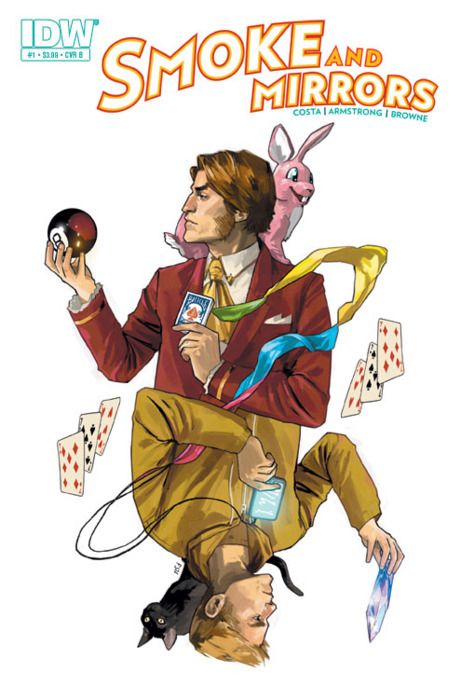"Smoke and Mirrors" #1 isn't a magical comic book, but it certainly is unusual. Set on a planet powered by magic, this initial chapter provides some rudimentary information and valuable knowledge sharing for the story yet to come.
"Smoke and Mirrors" opens with a Steve Jobs-like presentation being given by a character we come to know as Steven J. Carroll. Much like Jobs to Apple, Carroll is the figurehead of the Trade Circle -- the biggest technological corporation of this magical world. Trade Circle corners the market on charms and spells for powering devices, like music boxes and slates and not unlike the mega-corporations of our world, enthralls the populace with new ideas and spells.
Through this presentation, Mike Costa introduces us to Ethan Vernon, a gifted yet troubled student. Ethan carries the burden of teen angst in an almost stereotypical manner, looking for new thrills, big ideas, and something... better. That leads him into trouble and eventually brings him to cross paths with the soon-to-be-protagonist of the title.
Terry Ward is a slight of hand magician who isn't plugged into the anima mundi -- the magical energy around the world that all charms and spells stem from-- and therefore brings all manner of outlandish items and concepts to this world steeped in magic of a different strain. Through Ward, Costa (and magical advisor, Jon Armstrong) give the reader a chance to participate in a magic trick. That's right, a real magic trick, printed on the page the reader is a part of. Luckily it has nothing to do with a saw, but it is impressive to see, especially given the pacing of the story that plays the trick into the wonders of comic book pacing and page turning. For that alone, this book will be memorable.
Unfortunately, there's just a little too much moping through this comic for the story or characters to distinguish themselves. Carroll is a little too much like Jobs and Ethan is a little too teen angsty for either character to encourage the reader to come back for more. The promise of additional magic tricks, however, is selling high in appeal.
Ryan Browne's artwork is inconsistent throughout the book. Some scenes are well assembled and dramatic with characters playing through the panels nicely, but other scenes seem hurried and incomplete. Quite a few of Browne's characters suffer from sameface, but those people tend to fall to the backgrounds. There is no mistaking or confusing the four main players in this story, and Browne brings his very best work to all of the scenes with Terry Ward present.
This comic book has a great deal of potential, but it hasn't quite figured out how to dispense it in an even manner. The brilliance comes in fits and stops, just enough to encourage pleading for more, but never quite delivering. "Smoke and Mirrors" is a wonderfully innovative concept that just needs a little stronger execution. The talent is here, they just need to shine.

